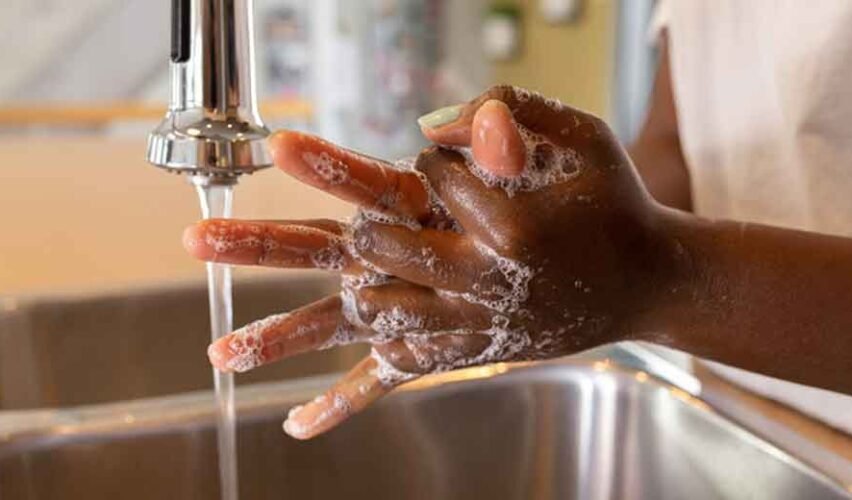Hospitals fight germs every day. People come in sick, and the goal is to stop those germs from moving to other patients, staff, or visitors. The routine is calm, steady, and clear. No magic tricks. Just good habits done well, again and again. Those habits work at home, too. With a few smart moves, any house can borrow the best parts of hospital hygiene without turning the living room into a lab.
What “Clean” Means vs “Disinfected”
These two words get mixed up a lot, which leads to weak results. Cleaning means removing dirt and germs you can’t see by lifting them off a surface. A damp cloth with soap does this. Disinfecting means killing germs that remain after cleaning. That step needs a product meant to kill germs and enough time left on the surface to work.
Hospitals do both. First, remove mess. Then, apply a product that kills germs and let it sit for the contact time on the label. Wiping it off too soon is like taking off a bandage before the cut closes.
Hand Hygiene: The Small Habit That Stops Big Problems
Hand cleaning is the single strongest move in a hospital. Staff wash or sanitize at key moments: before touching a patient, after contact with body fluids, and after touching high-touch areas. At home, the same idea holds. Wash with soap and water for about 20 seconds. Rub all parts of the hands, including thumbs and the tips of fingers. Dry well. If hands are not visibly dirty, an alcohol gel works when a sink is not nearby.
Make it easy to do the right thing. Keep soap at every sink. Place a small sanitizer pump at the front door and in the kitchen. Remind children to wash after the bathroom and before eating. Simple reminders turn into habits.
Surfaces That Matter Most
Hospitals focus on “high-touch” spots because germs spread fastest there. Think door handles, bed rails, faucet handles, tablet screens, and light switches. Homes have the same hot zones: phone screens, remote controls, fridge handles, tap handles, and the edge of the kitchen table where hands rest.
Pick a short list of these spots and clean them daily. After that, use a disinfectant and let it sit for the full contact time. Many people spray and wipe right away. That wastes effort. The label time is not a guess; it is the tested time that kills the germs listed.
Choosing Tools That Actually Work
Hospitals don’t pick products for scent or shine. They choose based on proof. Look for clear labels that state what germs the product kills and how long it needs to stay wet. For homes with higher risk—newborns, older adults, or anyone with a weak immune system—some families choose hospital-grade products for kitchens, bathrooms, and sick-day cleanup. The key is to match the tool to the job, not to use the strongest option everywhere.
How to Read a Disinfectant Label Without Overthinking It
Labels can feel crowded, but a few parts matter most. First, the contact time: this is the number of minutes the surface must stay wet. Set a timer if that helps. Second, the list of target germs. During flu season, pick a product with claims against flu viruses. For stomach bugs, look for claims that cover norovirus or similar. Third, directions for use. Some products need a pre-clean step. Others come ready to use. Follow the steps in order. Skipping one step lowers the result.
When to Use Stronger Measures at Home
Not every moment calls for maximum power. Routine days need routine cleaning. Hold the stronger moves for times with real risk. Use a disinfectant after raw meat juice spills on a counter. Use it after someone has thrown up, had diarrhea, or sneezed across a hard surface. Use it when caring for a cut, a scrape, or a diaper area.
During a household outbreak—say a child has the flu—tighten the routine. Increase hand cleaning. Disinfect bathroom handles, taps, and light switches twice a day. Give sick people their own towel and, if possible, their own bathroom space.
The Right Order: Clean, Then Disinfect, Then Leave It Alone
Order matters. First, remove crumbs, grease, and visible mess with soap and water or a mild cleaner. Second, apply the disinfectant to the now-clean surface. Third, walk away until the time on the label is done. Do not fan the surface dry. Do not wipe it early. This pause is the moment the product earns its keep.
For wipes, the same rules apply. One wipe has only so much liquid. If a wipe dries out, it can’t do its job. Use enough wipes to keep the surface wet for the full time. On a large table, that may take several.
Air Moves Matter Too
Hospitals pay attention to air. Good airflow lowers the chance that tiny droplets hang around. At home, the handiest move is to open a window for a short time when weather allows. Run the bathroom fan during and after showers. If someone is sick, keep fresh air moving in the room and limit close contact. A well-fitting mask helps if you need to be near the person for care. Clean your hands after removing the mask.
Laundry and Soft Surfaces
Germs do not only live on hard counters. Sheets, towels, and clothes pick them up too. Hospitals bag dirty linens, wash on a warm or hot cycle that the fabric allows, and dry items fully. At home, keep laundry from sick people in a separate bag. Avoid hugging the pile to the chest. Wash hands after loading the machine. Clean the hamper and the top of the washer each week, as those spots collect handprints.
Smart Use of Gloves and Cloths
Gloves are not magic. They protect hands, but they also carry germs if used the wrong way. In hospitals, staff change gloves between tasks and wash hands after removing them. At home, if gloves are used, take them off without touching the outside and clean hands right after.
For cloths and sponges, separate by task. Use one cloth for bathrooms and another for the kitchen. Wash cleaning cloths in hot water and dry them. Replace sponges often. If a sponge smells, it is time to retire it.
Common Mistakes to Avoid
Mixing products can create gas that harms lungs. Never mix bleach with ammonia or vinegar. Spraying more does not mean better; it only wastes liquid and may leave streaks. Rushing the process reduces results. The last mistake is saving the worst spot for last. Clean from the cleaner area to the dirtier area, then wash hands. That way, germs do not travel backward across the room.
A Simple Home Routine That Mirrors the Pros
A steady routine beats random deep cleans. Here is a clear plan that is easy to keep. In the morning, wipe and disinfect bathroom handles and taps while the coffee brews. After dinner, clean kitchen counters, the table edge, and fridge handles. Once a day, wash the most used hand towels. Twice a week, give phones and remotes a careful clean and a full disinfectant contact time. During any illness in the house, step this up until the sick person has been fever-free for a full day without medicine.
Teaching Kids and Helping Guests Help You
Homes run smoother when everyone knows the plan. Show kids how to wash hands and sing a short song to hit 20 seconds. Give each child a personal towel hook. Place a small trash bin near the bathroom sink for tissues. When guests arrive, a simple “there is sanitizer by the door” sets the tone without stress. Clear cues guide behavior better than long lectures.
What to Do When Time Is Tight
Life gets busy. When the schedule explodes, hit the highest-risk spots first. Hands, bathroom taps, toilet flush, kitchen counters, and phones give the best return for effort. A three-minute sprint on those areas keeps the home safer until there is space for a fuller clean. If energy is low, set a timer for five minutes and stop when it rings. Any progress beats waiting for a “perfect” clean that never gets started.
Quick Wrap-Up
Hospitals win against germs by doing small steps well, in the right order, every day. Clean to remove mess. Disinfect and let the surface stay wet for the label time. Focus on hands and high-touch spots. Keep fresh air moving when possible. Save stronger products for moments that matter.
Pick one change to start this week, such as timed contact on bathroom taps or daily phone cleaning. After it sticks, add another. Share these steps with family members. A simple plan done together keeps everyone safer and makes sick days less common.



